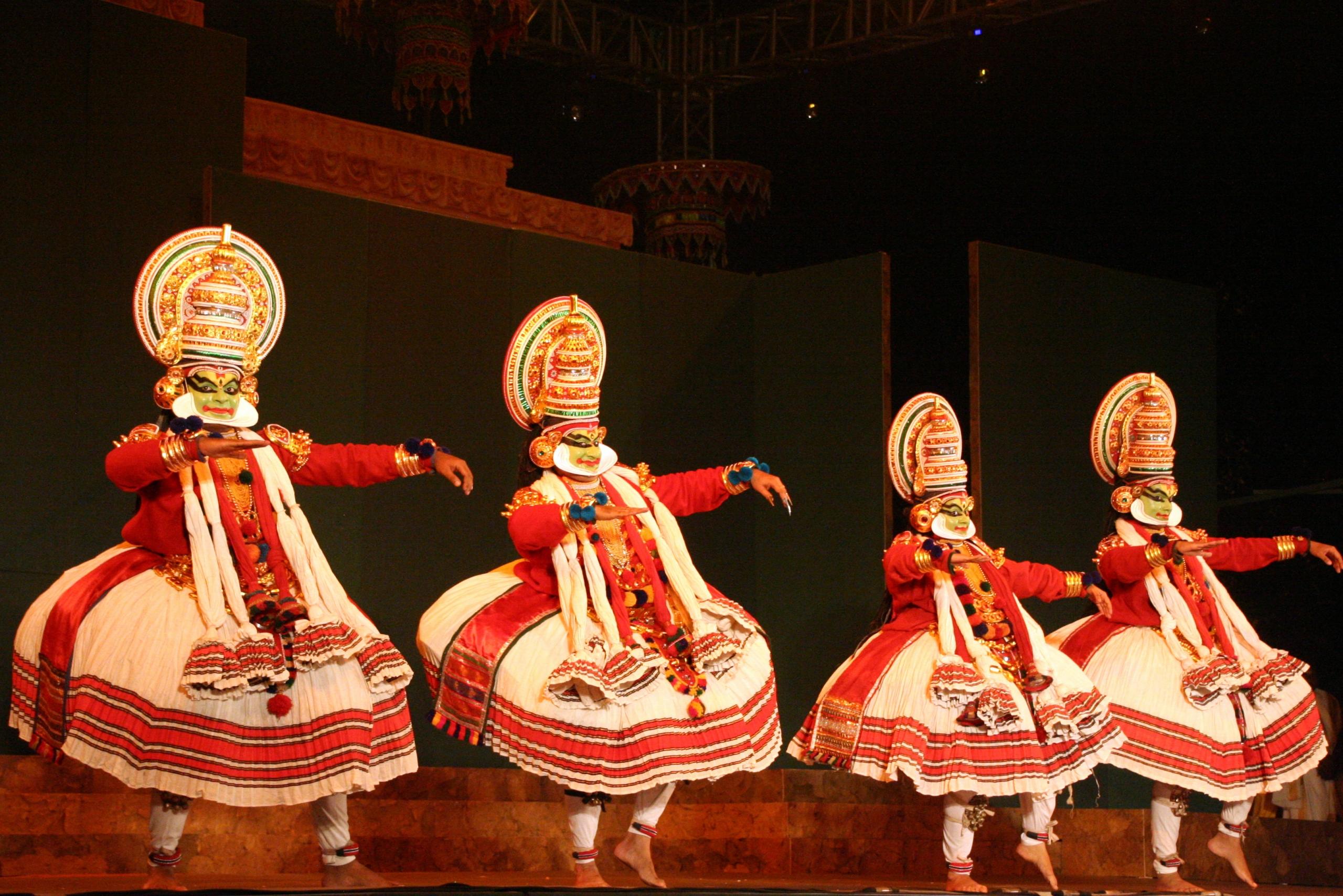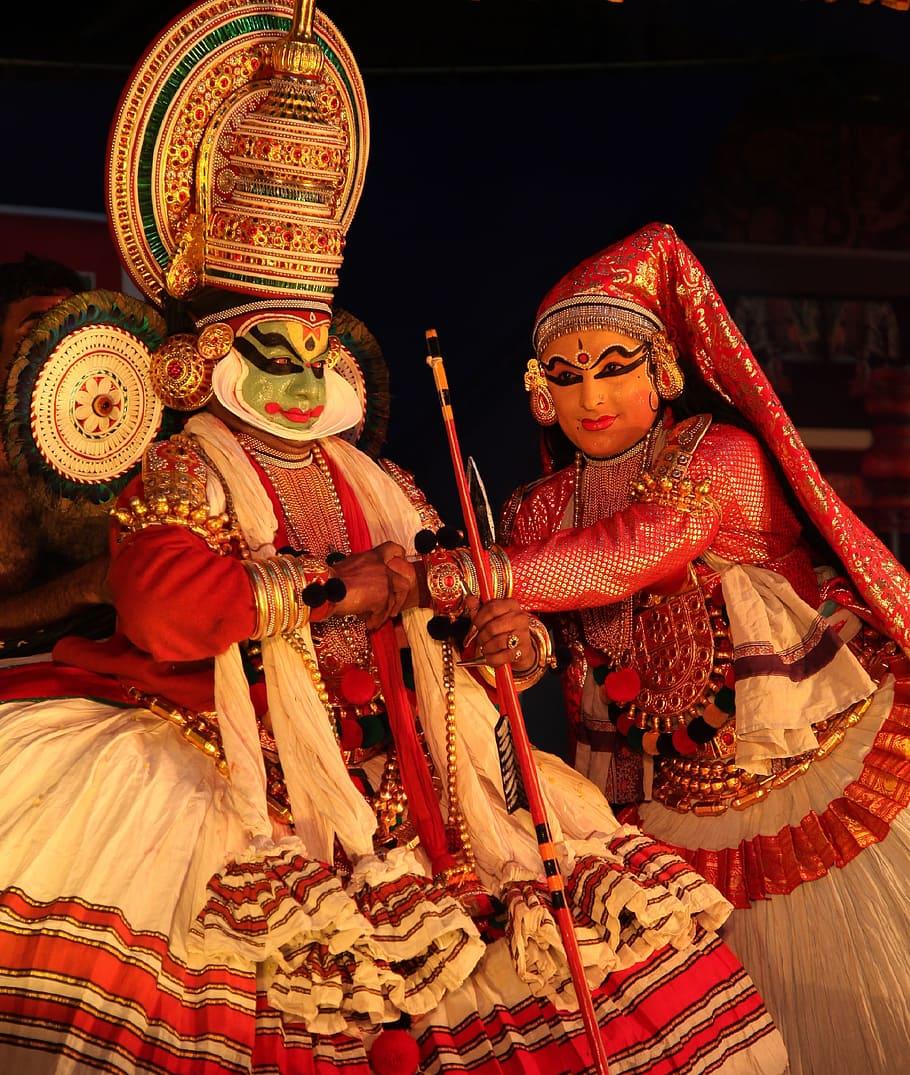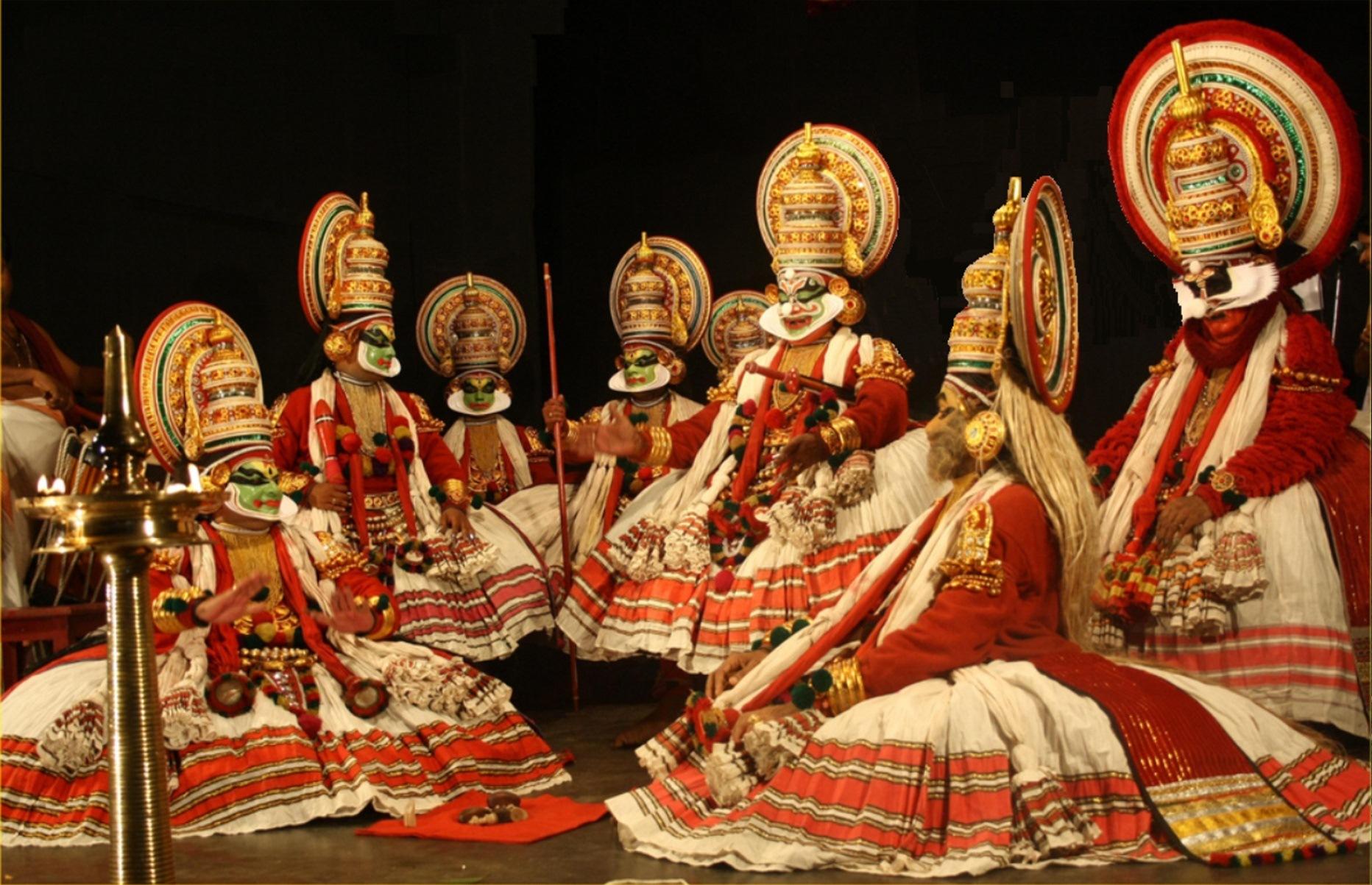Kathakali is the classical dance-drama of Kerala, known for its elaborate costumes, expressive gestures, and storytelling tradition. When we talk about the history of Kathakali dance, it is believed to have originated in the late 16th century as a fusion of earlier temple arts. Let’s take a quick look at the timeline of how this magnificent Kathakali Kerala dance evolved through history.
Timeline of Kathakali Dance
- 16th century (c. 1555 CE): Roots of Kathakali trace back to temple rituals and earlier art forms like Kutiyattam, Krishnattam, and folk traditions.
- 17th century (c. 1600 CE): Emergence of Kathakali as a distinct dance-drama form under the patronage of Raja of Kottarakkara in Kerala.
- 17th century (late): Kottayam Thampuran refines the art form by introducing more dramatic stories from the Ramayana and Mahabharata.
- 18th century: Kaplingadan Namboodiri and other masters establish performance conventions, makeup (chutti), and codified gestures (mudras).
- 19th century: Kathakali spreads beyond temple courtyards into cultural festivals and becomes a symbol of Kerala’s artistic heritage.
- 20th century: Revival efforts by poets like Vallathol Narayana Menon and institutions like Kerala Kalamandalam (founded in 1930) secure its place on the world stage.
- 21st century: Kathakali is recognized globally as one of India’s most iconic classical dance forms, blending tradition with modern presentation.
Kathakali, a hybrid of dance and mime, has its roots in Kerala and dates back to the 16th and 17th centuries—roughly the same period as Shakespeare. Kathakali dancers perform in the Kalluvazhi Chitta style, which originated over two centuries ago on the stage of the now-closed Olappamanna Mana Kathakali school in Vellinezhi.
Originally, it was taught in boarding schools with live-in teachers, known as ashans, who oversaw students strictly. Dance drama in the style of kathakali ("story play") comes from Kerala. Less than a third of the 101 classical Kathakali stories are currently presented on stage.
There are 24 fundamental hand gestures (mudras), 24 Kathakali faces (emotions or rasas), and other body movements that are used to enact the story. To improve the readability of their hand movements, several characters have long steel or silver nails on their left fingers.
In addition to the basic mudras, there are 470 different symbols used throughout the Kathakali performance.
Kathakali dancers bring attention to their inner faces and eyes by wearing a white facial border, or chutti, composed of thick drawing sheets. These were constructed from rice paper up to the 1960s. Hindu worship rites, like the Theyyam, which are said to be over 2,000 years old, have had a major influence on Kathakali.
Blend into the living art tradition of the Chhau dance form.

Origin and Evolution of Kathakali
One of the most well-liked traditional dance styles in India is Kathakali. It is essentially a classical dance of Kerala, which is popular throughout southwest India. It is one of the liveliest dancing styles since the dancer does it while donning brightly colored costumes, masks, and other accessories. The main purpose of Kathakali is for the dancer to use his performance to tell a story. The primary source of inspiration is thought to have been the folk arts and temples of southern India.

What Is Kathakali?
The traditional name of this dance form was derived by combining two words: 'Katha' and 'Kali.' In Sanskrit, 'Katha' signifies a traditional tale or story, while 'Kali,' derived from 'Kala,' alludes to art and performance.
In Kathakali, the classical dance-drama of Kerala, there are seven primary types of characters, each with distinct roles, costumes, makeup, and movements. These characters are broadly categorized into "Veshams", which refer to the different facial makeups and costumes worn by the performers.
Pacha, Kathi, Thadi, Kari, Minukku, Stree Vesham and Special Characters
It is widely acknowledged that Kottarakkara Thampuran is the father of Kathakali dance form. He was regarded as one of this dance form's greatest performers as well. Thampuran was the first to record a dance drama in this particular dance style. The Ramayana was represented by the eight divisions that were created inside this dance genre. Ramanattam is the name given to this Kathakali rendition of the Ramayana.
The folk arts and other ancient classical dance forms of Kerala, such as "Porattunatakam," as well as ancient and ritualistic art forms like "Padayani," "Teyyam," and "Mudiyettu," are thought to have influenced the development of "Kathakali." There are obvious traces of "Kalaripayattu," an antiquated martial art form with Keralan roots, in the dancers' varied motions.
Even though "Kathakali" borrows and reflects many elements from various Hindu temple art forms, what makes it unique is how the actor-dancers focus solely on acting and dancing to convey the emotion of the scene, while the voice artist delivers the lines—a stark contrast to earlier forms where the actor-dancers also performed the vocal portion.
According to author Phillip Zarrilli, the fundamental elements and distinguishing characteristics of this style of classical dance may be found in the ancient Sanskrit Hindu treatise known as "Natya Shastra," a work on the performing arts penned by the sage Bharata Muni, an Indian musicologist and theatricist. Many aspects of "Kathakali" are comparable to "Kutiyattam," a type of Sanskrit theater that is customarily performed in Kerala.
Learn about the history of Bharatnatyam.
The subjects of "Kathakali" have historically been drawn from religious sagas, myths, folktales, stories, and spiritual ideas found in the Hindu epics and "Puranas." In addition to these topics, contemporary Indian "Kathalaki" troupes have adapted stories from well-known writers including William Shakespeare and Western plays as well as Christian legends. Another change to the modern "Kathakali" is the presence of women in the company, which was formerly made up entirely of men. The vocal portion is still Sanskritized Malayalam according to tradition.
Learn about the evolution of the Kathak dance style in India over the years.
Kathakali Dance Style
The five principal roles of this well-liked dance style are referred to as the pacha vesham of Kathakali. They can be described as:
- Pacha (green): This is a symbol for a variety of heavenly entities. It is primarily used in Kathakali dance to indicate exalted roles.
- Kathi (knife): This is used to represent characters that are bad and exhibit traits like rudeness, haughtiness, and so on.
- Kari (black): This is also employed to represent the villainous figures.
- Thaadi (beard): Included in this element is the Vella Thaadi which is also a symbol for the white beard and is used to indicate good traits. It is used to illustrate Ramayana characters. Conversely, the Chuvanna Thaadi is utilized in Hindu mythology to represent malevolent characters.
- Minukku (radiant): This is a character type used to represent spirituality.

Discover the story of the Odissi dance.
Kathakali Costumes
There are many different costumes used in Kathakali, and each one is worn according to the role the dancer is about to play. They comprise the masks that are worn differently from one another, the cosmetics, and the headgear that males wear. Dark-coloured, full-sleeved jackets are typically worn by men. Kathakali dancers also don voluminous skirts.
With the exception of the Minukku dancer, every dancer has the same skirt at the bottom of their outfit. The female Kathakali dancers dress in white sarees and wear crimson jackets, an embellished scarf, and a top knot tied near their foreheads. Bracelets, necklaces, bangles, ankle bells, and other items are examples of ornaments worn during a Kathakali performance.
Find amazing dance classes in Delhi.
Accompanying Music
During a Kathakali performance, a variety of instruments are used, including the three main drums: itaykka, centa, and maddalam. This classical dance of Kerala heavily incorporates music, setting and matching different tones to the mood of a given scene. Some of the key musical selections include:
- Cempata is used in a variety of contexts, such as battles between good and evil and at the end of scenes.
- Atanta is used in scenes involving divine and moral figures.
- Muri Atanta is used in heroic, humorous, and lighthearted acts.
- Triputa is used in scenes involving teachers and sages.
- Pancari is used in scenes depicting scenes of disgust.
- Campa is used in scenes that depict clashes, arguments, tension, and discord between lovers.
Explore the myriad hues of Manipuri dance style.
The voice actors play an important role throughout the entire performance. They modulate their voices to convey the character's temperament and build the scene's tone in addition to delivering the pertinent phrases. When the artist is angry, they will speak in a clear, high-pitched voice; when they are pleading, they will use a more fragile, worn-out tone.
Famous Kathakali Exponents
Kalamandalam Gopi
Known for portraying gentle and pious characters, or Pacha characters as they are technically called in Kathakali, Kalamandalam Gopi is most known for his role as Arjuna in the Kathakali play Kalakeyavadham. His portrayal of Nala has been remarkable, as has been his portrayal of Karna in the drama Karnasapadham. In addition, Mr. Gopi's portrayal of characters in the Kathi tradition is distinctive. He enjoys playing Ravana in Ramba Pravesam as well as Keechaka. Kalamandalam Gopi is a performer who captivates the audience with his ability to achieve flawless beauty while retaining certain postures that go well with the emotional aspects of the characters he presents.
Immerse yourself in the wonderful history of Kuchipudi.
Kottakal Sivaraman
Prominent performer Kottakkal Sivaraman is rightly regarded as the pioneering Kathakali artist who endeavoured to encourage and acknowledge female roles in Kathakali with sufficient vigour and was successful in doing so. Sivaraman has been a Kathakali performer for almost fifty years, and throughout that time he has portrayed numerous iconic female roles. In both north and south Kerala, he has performed on stage alongside performers spanning multiple generations. On the Kathakali stage, though, he was a superb duo with another veteran, Padmashree Kalamandalam Gopi. Among their most noteworthy roles were those of Kunti and Karnan, Mohini and Rugmangadan, and Kottakkal Sivaraman as Damayanti and Gopi as Nalan.
Learn with dance classes in Mumbai.
Kalamandalam Ramankutty Nair
Ramankutty Nair was highly praised for both his effortless interpretation of plays with rigorous grammar and choreography and his commitment to the Kalluvazhi tradition, which was established by his instructor, Pattickamthodi Ramunni Menon. Nair is mostly known for portraying rajo guna (virtuous but evil) figures like Ravana, Duryodhana, Keechaka, and Narakasura using Kathi makeup. For many enthusiasts, his portrayals of these characters have become the benchmark.
Unravel the origins of Mohiniyattam, a classic among classics.

Significance of the Kathakali Dance Tradition
Keralan art and culture are embodied in the exquisite dance genre of Kathakali. In addition to using beautiful expressions, and hand and foot movements, this dance style is distinguished from other Indian classical dance forms by its distinctive clothing. Another key component of this dance's attractiveness is the mask. In addition to involving dance, the term suggests that it also places a strong emphasis on acting, since the dance is performed in order to fully convey a mythological tale.
Lose yourself in the unique history of the Sattriya dance form.
There are additional meanings that this dance imparts to the dancer's physical form. Additionally, it promotes relaxation and amplifies a dancer's overall expressive potential. Any performer who embodies this dance conveys a powerful message to the audience by drawing them in with their elegant message and unique attire. Both the dancer's expression and the dancer's makeup are used to read kathakali. The two major characters in the dance, good and evil, are distinguished from one another by the dancer's face paint and masks.
Become an expert in dance when you enroll in a dance class near me on Superprof.
According to Hinduism, Kathakali is the embodiment of humanity and a storytelling genre of dance. It offers a chance to reflect on the past as it changed during the 17th century. This type of dance incorporates the idea of dedication in addition to being a dance drama. The dance's primary goal is to tell a tale through a dance drama that is visually striking and emotive thanks to its colourful costumes.















